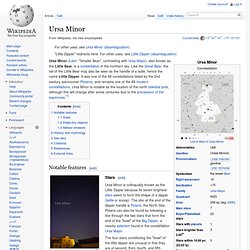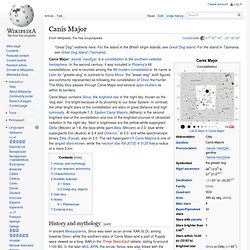

Ursa Minor. Ursa Minor (Latin: "Smaller Bear", contrasting with Ursa Major), also known as the Little Bear, is a constellation in the northern sky.

Ursa Major. Orion (constellation) The earliest depiction that has been linked to the constellation of Orion is a prehistoric (Aurignacian) mammoth ivory carving found in a cave in the Ach valley in Germany in 1979.

Archaeologists have estimated it to have been fashioned approximately 32,000 to 38,000 years ago.[2][3][4] The distinctive pattern of Orion has been recognized in numerous cultures around the world, and many myths have been associated with it. It has also been used as a symbol in the modern world. The Babylonian star catalogues of the Late Bronze Age name Orion MULSIPA.ZI.AN.NA,[note 1] "The Heavenly Shepherd" or "True Shepherd of Anu" - Anu being the chief god of the heavenly realms.[5] The Babylonian constellation was sacred to Papshukal and Ninshubur, both minor gods fulfilling the role of 'messenger to the gods'. The stars of Orion were associated with Osiris, the sun-god of rebirth and the afterlife, by the ancient Egyptians.[7][8][9]
Draco (constellation) Cygnus (constellation) Cygnus contains Deneb, one of the brightest stars in the night sky and one corner of the Summer Triangle, as well as some notable X-ray sources and the giant stellar association of Cygnus OB2.

One of the stars of this association, NML Cygni, is one of the largest stars currently known. The constellation is also home to Cygnus X-1, an distant X-ray binary containing a supergiant and unseen massive companion that was the first object widely held to be a black hole. Many star systems in Cygnus have known planets as a result of the Kepler Mission observing one patch of the sky, the patch is the area around Cygnus.
Cygnus as depicted in Urania's Mirror, a set of constellation cards published in London c.1825. Surrounding it are Lacerta, Vulpecula and Lyra. Canis Minor. Canis Minor contains only two stars brighter than the fourth magnitude, Procyon (Alpha Canis Minoris), with a magnitude of 0.34, and Gomeisa (Beta Canis Minoris), with a magnitude of 2.9.

The constellation's dimmer stars were noted by Johann Bayer, who named eight stars including Alpha and Beta, and John Flamsteed, who numbered fourteen. Procyon is the seventh-brightest star in the night sky, as well as one of the closest. A yellow-white main sequence star, it has a white dwarf companion. Gomeisa is a blue-white main sequence star. Canis Major. An image of Canis Major (top right) as seen from an airplane at around 8 degrees north (Andaman Sea west of Thailand).

Canis Major contains Sirius, the brightest star in the night sky, known as the 'dog star'. It is bright because of its proximity to our Solar System. In contrast, the other bright stars of the constellation are stars of great distance and high luminosity. At magnitude 1.5, Epsilon Canis Majoris (Adhara) is the second brightest star of the constellation and one of the brightest sources of ultraviolet radiation in the night sky. Next in brightness are the yellow-white supergiant Delta (Wezen) at 1.8, the blue-white giant Beta (Mirzam) at 2.0, blue-white supergiants Eta (Aludra) at 2.4 and Omicron1 at 3.0, and white spectroscopic binary Zeta (Furud), also at 3.0. History and mythology[edit] In non-western astronomy[edit] Canis Major as depicted in Urania's Mirror, a set of constellation cards published in London c.1825. Characteristics[edit] Notable features[edit] Ophiuchus. Ophiuchus /ɒfiˈjuːkəs/ is a large constellation located around the celestial equator.

Its name is from the Greek Ὀφιοῦχος "serpent-bearer", and it is commonly represented as a man grasping the snake that is represented by the constellation Serpens. Ophiuchus was one of the 48 constellations listed by the 2nd-century astronomer Ptolemy, and it remains one of the 88 modern constellations. It was formerly referred to as Serpentarius /sɜrpənˈtɛəriəs/ and Anguitenens. Location[edit] Ophiuchus straddles the equator but lies predominately to its north. In contrast to Orion, it is in the period November–January (summer in the Southern Hemisphere, winter in the Northern Hemisphere) when Ophiuchus is in the daytime sky and thus not visible at most latitudes. Notable features[edit] The constellation Ophiuchus as it can be seen by naked eye.[1]